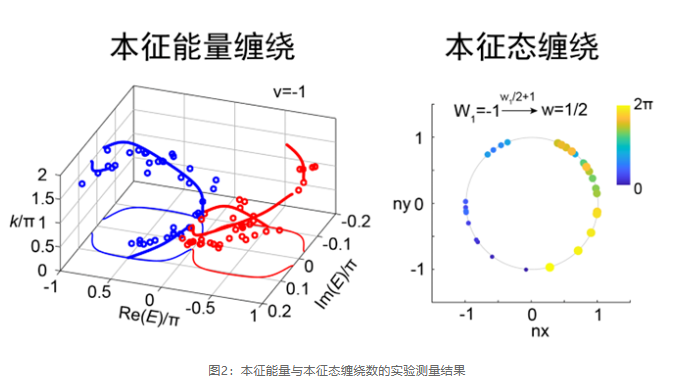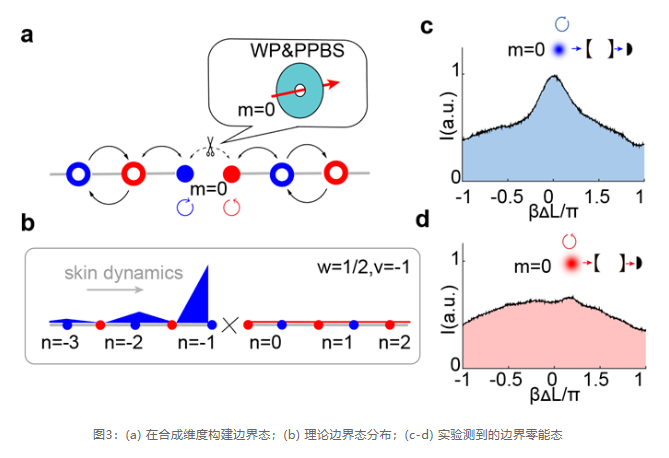20
2025
-
08
Research on Non-Hermitian Properties Assisted by Orbital Angular Momentum Synthesis Dimensions
Author:
In quantum mechanics, observables usually need to satisfy Hermiticity to ensure that their eigenvalues are real numbers. However, real physical systems inevitably couple with the environment, leading to open and dissipative characteristics, which in turn introduce non-Hermitian properties. The development of non-Hermitian theory provides a concise and intuitive framework for describing such open systems and non-equilibrium topological states.
In recent years, a large number of non-trivial topological states have been discovered in non-Hermitian systems, sparking widespread interest in extending topological concepts into the non-Hermitian realm. Compared to traditional Hermitian systems, non-Hermitian topological systems exhibit many novel phenomena, such as new types of topological classification, non-Hermitian skin effect, etc. In periodic non-Hermitian systems, the eigenenergy spectrum takes on a complex form and exhibits unique winding behavior in the complex plane. The topological winding number of the eigenstates also breaks the limitation of only taking integer values in Hermitian systems, allowing for half-integer values. However, how to directly observe these winding characteristics in experiments, especially the half-integer winding numbers, still faces significant challenges.
Recently, a research team led by Professor Li Chuanfeng, Professor Xu Jinshi, Professor Luo Xiwang from the University of Science and Technology of China, and postdoctoral researcher Yang Mu, among others, , based on the orbital angular momentum (OAM) degree of freedom to construct synthetic dimensions, successfully constructed a non-Hermitian topological lattice, achieving direct observation of the eigenenergy and eigenstate winding behavior. This is the first time that half-integer eigenstate winding numbers in non-Hermitian systems have been observed experimentally, revealing its intrinsic connection with topological boundary states on semi-infinite chains. The related results were published in a paper titled Observing Half-Integer Topological Winding Numbers in Non-Hermitian Synthetic Lattices in the journal 'Light: Science & Applications' 。
Non-Hermitian Systems and Synthetic Dimensions: Breakthroughs from Theory to Experiment
Phenomena such as complex energy spectra, non-reciprocity, skin effect, and bulk-boundary correspondence breaking in non-Hermitian topological systems constitute the forefront of current physical research. However, limited by the construction capabilities of experimental platforms, the systematic exploration of these phenomena remains relatively lagging. In recent years, with the rise of the concept of "synthetic dimensions," scientists have been able to simulate high-dimensional spaces by manipulating the intrinsic degrees of freedom of particles (such as the frequency of light, orbital angular momentum, atomic energy levels, etc.), providing a new path for constructing complex non-Hermitian topological systems.
Compared to traditional methods of constructing topological lattices in real space, the use of optical synthetic dimensions has the following significant advantages:
-
Reduced complexity: By using the degrees of freedom of particles instead of real spatial structures, it reduces the dependence on high-precision spatial structure manufacturing.
-
Highly controllable parameters: Dynamic adjustment of mode coupling can be achieved through mature optical devices (such as wave plates, Q plates), facilitating the simulation of different Hamiltonians.
-
Diverse detection methods: Each synthetic degree of freedom can correspond to a specific detection method, allowing key topological information to be directly obtained.
Experimental Design and Key Results
The research team constructed a standing wave resonator that supports multi-orbital angular momentum modes ( Figure 1a ). By introducing Q plates and wave plates into the cavity, they achieved coupling between orbital angular momentum and spin angular momentum (polarization), resulting in coupling between different modes. Further introducing polarization-related losses into the system simulated a synthetic orbital angular momentum lattice with non-Hermitian characteristics ( Figure 1b ), thereby inducing the non-Hermitian skin effect.

In the experiment, the team simultaneously measured the eigenenergy winding number and eigenstate winding number of the system for the first time through transmission spectrum sweeping and output state polarization projection measurements ( Figure 2 ). This provides unprecedented experimental means to directly characterize non-Hermitian topological properties.
Corresponding author Professor Xu Jinshi pointed out: "In non-Hermitian systems, the topological winding number is not only an important representative of topological invariants but also reflects the deep structure of the system's symmetry. Especially, the characteristic of the eigenstate winding number being half-integer has not been observed in experiments before."

Boundary States and Topological Invariants: A New Understanding Breaking Bulk-Boundary Correspondence
The first author of the paper, Dr. Yang Mu, further elaborated: "In the study of topological materials, what is most fascinating is the correspondence between topological invariants and boundary states. However, the non-Hermitian skin effect enhances the coupling between finite lattice boundaries, thereby breaking the traditional bulk-boundary correspondence."
To overcome this issue, the research team cleverly constructed two "equivalent semi-infinite" synthetic lattices by breaking the coupling at the OAM = 0 position ( Figure 3a ), where they observed boundary zero-energy states determined by half-integer winding numbers ( Figure 3b-d ). This is the first experimental verification of the correspondence between half-integer topological invariants and boundary states in non-Hermitian systems.

Looking Ahead: Expanding Non-Hermitian Physics Boundaries with Synthetic Dimension Platforms
This is another important progress made by the research team following previous related studies [ Nat. Commun. 13, 2040 (2022), Sci. Adv. 9 , eabp8943 (2023), Photon. Res. 13, 87 (2025)] on synthetic dimension platforms. This work not only experimentally confirms the existence of half-integer topological invariants in non-Hermitian systems for the first time but also further reveals the physical image of their corresponding boundary states, laying an important foundation for future exploration and device applications of non-Hermitian topological physics.
Previous
Previous
LATEST NEWS
2025-12-17
Beijing Institute of Technology Review: Infrared Detectors for In-Memory Sensing and Computing
2025-12-17
High-performance III-V family infrared detectors
Since the advent of infrared detectors in the 1940s, their technological framework has undergone leapfrog development, with significant expansions in both device types and performance.

